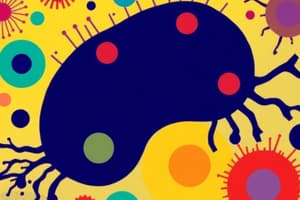Podcast
Questions and Answers
What is the term for an organism that lives on dead or decaying matter?
What is the term for an organism that lives on dead or decaying matter?
- Parasite
- Pathogen
- Saprophyte (correct)
- Symbiote
What term is used for microbes that colonize the human body but do not normally cause disease?
What term is used for microbes that colonize the human body but do not normally cause disease?
- Saprophytes
- Opportunistic pathogens
- Nonpathogens (correct)
- Pathogens
Which term refers to microbes that can cause diseases when they access a part of the body where they shouldn't be?
Which term refers to microbes that can cause diseases when they access a part of the body where they shouldn't be?
- Opportunistic pathogens
- Saprophytes
- Nonpathogens
- Pathogens (correct)
What percentage of known microorganisms have the ability to cause diseases?
What percentage of known microorganisms have the ability to cause diseases?
What is the term for organisms that do not cause disease?
What is the term for organisms that do not cause disease?
What is the science of investigating small objects using an instrument with a series of glass lenses called?
What is the science of investigating small objects using an instrument with a series of glass lenses called?
Which category of microbes lacks cellular organization and cannot be seen in a light microscope?
Which category of microbes lacks cellular organization and cannot be seen in a light microscope?
What is a distinguishing feature of eukaryotic cells compared to prokaryotic cells?
What is a distinguishing feature of eukaryotic cells compared to prokaryotic cells?
Which microorganisms are examples of eukaryotes?
Which microorganisms are examples of eukaryotes?
What is a distinguishing characteristic of prokaryotes?
What is a distinguishing characteristic of prokaryotes?
Which type of organisms reproduce through binary fission and can be found in various ecosystems?
Which type of organisms reproduce through binary fission and can be found in various ecosystems?
What is the shape of some bacteria that have a comma shape or a flexible, wavy shape?
What is the shape of some bacteria that have a comma shape or a flexible, wavy shape?
What are the main types of organisms that make up the microbial world?
What are the main types of organisms that make up the microbial world?
What is the term often used interchangeably with 'microorganisms'?
What is the term often used interchangeably with 'microorganisms'?
Who is referred to as the 'Father of Microbiology'?
Who is referred to as the 'Father of Microbiology'?
What does the term 'germ' derive from?
What does the term 'germ' derive from?
Which living organisms are visible only with a microscope?
Which living organisms are visible only with a microscope?
What did Anton van Leeuwenhoek observe in his specimens that he called 'animalcules'?
What did Anton van Leeuwenhoek observe in his specimens that he called 'animalcules'?
Flashcards are hidden until you start studying
Study Notes
Scope of Microbiology
- Microbiology is the study of all living organisms that are too small to be visible with the naked eye.
- This includes bacteria, viruses, fungi, protozoa, prions, archaea, and algae, collectively known as "microbes".
Parasitology
- Parasitology is the study of parasites, their hosts, and the relationship between them.
Microbes
- Microbes are microscopic living organisms that are visible only with a microscope.
- Also known as "microorganisms".
Evolution of Microbiology
- In the past, people attributed diseases to witchcraft and the devil.
- Later, they believed disease was caused by miasma (an unpleasant or unhealthy smell).
- Anton van Leeuwenhoek (1632-1723) is known as the "Father of Microbiology", "Father of Bacteriology", and the "Father of Protozoology".
- He was the first to demonstrate the presence of microorganisms via a microscope.
Categories of Microbes
- Acellular Microbes: infectious particles, lacking cellular organization, not delimited by cytoplasmic membrane, and cannot be seen in a light microscope (e.g. viruses, viroids, virusoids, prions).
- Cellular Microbes: microorganisms, cytoplasmic membrane present, broken into prokaryotes and eukaryotes (e.g. all bacteria, all archaea, some algae, all protozoa, and some fungi).
Prokaryotes and Eukaryotes
- Prokaryotes: genome contained in a nucleus, probably the smallest living organisms, range in size from 0.15um (mycoplasmas) to 2.0 microscopic (many bacteria).
- Eukaryotes: cells where genomes are not contained within a nucleus, include microorganisms such as fungi, protozoa, and simple algae, larger and more complex than prokaryotic cells.
Bacteria
- Bacteria are prokaryotic organisms with no nucleus or nuclear membrane in their cells.
- They can take the form of rods (bacilli), spheres (cocci), or spirals (spirilla or spirochetes).
- They reproduce through binary fission, have unique ingredients in their cell walls, and can be found in nearly all of the world's ecosystems.
Microbiology and Human Health
- There are 500 to 1,000 different species of bacteria on and in humans, known as our indigenous microflora (also known as our indigenous microbiota).
- Opportunistic pathogens are microbes that colonize (inhabit) human body and can cause diseases if they gain access to a part of the body where they are not supposed to be.
- Microbes that cause disease are known as pathogens, while those that do not cause disease are called nonpathogens.
- Only around 3% of known microorganisms have the ability to cause disease.
Microscope
- A microscope is a series of glass lenses in a tube that produces an enlarged, focused image of a specimen.
- It is an instrument for viewing objects that are too small to be seen by the naked eye or unaided eye.
- Microscopy is the science of investigating small objects using such an instrument.
Studying That Suits You
Use AI to generate personalized quizzes and flashcards to suit your learning preferences.




